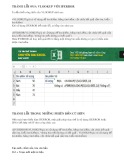
[ Team LiB ]
Recipe 4.7 Updating a Data Source with Data from a Different Data Source
Problem
You want to update a data source using changes made to another data source for data
replication or auditing purposes.
Solution
Use the GetChanges( ) method of the DataSet to identify changes made to a DataSet and
replicate these changes into a different data source.
The sample code contains two event handlers:
Form.Load
Sets up the example by setting up two DataSet objects each containing a single
table. The first table is filled with the Customers table from Northwind stored in
SQL Server; the second is filled with the Customers table from Northwind stored
in a MSDE instance. The default view of each table is bound to a data grid on the
form.
Update Destination Button.Click
Creates a new DataSet containing only the records that have changed in the
original data source. This DataSet is then used to apply the changes to a second
data source using its DataAdapter; the DataSet for the second data source is
reloaded. Finally, the first data source is updated with the changes.
The C# code is shown in Example 4-10.
Example 4-10. File: UpdateDataFromDifferentDataSourceForm.cs
// Namespaces, variables, and constants
using System;
using System.Configuration;
using System.Windows.Forms;
using System.Data;
using System.Data.SqlClient;
private DataSet dsSource, dsDest;
private SqlDataAdapter daSource, daDest;

// . . .
private void UpdateDataFromDifferentDataSourceForm_Load(object sender,
System.EventArgs e)
{
// Create the DataAdapter for the source records.
daSource = new SqlDataAdapter("SELECT * FROM Customers",
ConfigurationSettings.AppSettings["Sql_ConnectString"]);
SqlCommandBuilder cbSource = new SqlCommandBuilder(daSource);
dsSource = new DataSet( );
// Get the schema and data for the source.
daSource.FillSchema(dsSource, SchemaType.Source, "Customers");
daSource.Fill(dsSource, "Customers");
// Bind the default view of the customers table to the grid.
dataGridSource.DataSource = dsSource.Tables["Customers"].DefaultView;
// Create the DataAdapter for the destination records.
daDest = new SqlDataAdapter("SELECT * FROM Customers",
ConfigurationSettings.AppSettings["Sql_Msde_ConnectString"]);
SqlCommandBuilder cbDest = new SqlCommandBuilder(daDest);
dsDest = new DataSet( );
// Get the schema and data for the destination.
daDest.FillSchema(dsDest, SchemaType.Source, "Customers");
daDest.Fill(dsDest, "Customers");
// Bind the default view of the customers table to the grid.
dataGridDest.DataSource = dsDest.Tables["Customers"].DefaultView;
}
private void updateDestButton_Click(object sender, System.EventArgs e)
{
try
{
// Create a DataSet of the added, modified, and deleted records.
DataSet dsDelta = dsSource.GetChanges(DataRowState.Added |
DataRowState.Modified | DataRowState.Deleted);
if (dsDelta != null)
// Update the destination with the delta DataSet.
daDest.Update(dsDelta, "Customers");
// Reload the destination DataSet.
dsDest.Clear( );
daDest.Fill(dsDest, "Customers");

// Update the source.
daSource.Update(dsSource, "Customers");
}
catch(Exception ex)
{
MessageBox.Show("ERROR: " + ex.Message, "Fill Destination",
MessageBoxButtons.OK, MessageBoxIcon.Error);
}
}
Discussion
The ADO.NET DataSet contains data and schema information within its contained
objects, but not information about the provider that was used to retrieve the data or the
original source of the data. The DataSet tracks changes made to data by maintaining
multiple versions of each row allowing the data to be reconciled later to a data source
using a DataAdapter. The data source to which the DataSet is reconciled is usually, but
does not have to be, the original data source.
The GetChanges( ) method of the DataSet creates a copy of the DataSet containing all
changes that have been made to it since it was last retrieved from the data source or since
AcceptChanges( ) was last called.
To replicate the changes made to the first data source into the second data source, the
GetChanges( ) method of the first DataSet is called to retrieve a subset of rows that have
been added, modified, or deleted. This is the subset returned if the DataRowState filter
argument is not specified. Next, the Update( ) method of the destination DataAdapter is
called using the DataSet containing the changes as the data object argument; this applies
the changes to the destination data source. The destination DataSet is then cleared and
reloaded to reflect the applied changes. Finally, the changes are applied to the first data
source.
The technique demonstrated in this example relies on the changes made to a DataSet and
can therefore be used only to keep a second data source synchronized to a data source
that is being modified. It is called one-way replication. The destination data source server
does not have to be the same as the source database server, so an Oracle table could be
synchronized to reflect all changes made to a SQL Server table. In fact, the data sources
do not even have to be databases. If the destination data is not identical to the source data
or if the destination is updated outside of this synchronizing application, primary key
violations will occur if records with the same primary key as the source are inserted into
the destination. Concurrency errors will result if records are modified within or deleted
from the destination source. You could use application-specific logic to handle the

DataAdapter.RowUpdating to resolve these concurrency errors. For more information
about the RowUpdating event, see the Discussion section in Recipe 6.7.
The technique demonstrated in this example requires only slight modification to create an
audit trail of changes made to a DataSet. Instead of using the update logic generated by
the CommandBuilder for the destination DataAdapter, create custom update logic to
write the changes made to the source data, along with any other required audit
information such as a user ID or the date and time of the change, to the data destination.
One or more values from the DataRowState enumeration can be used to filter the changes
returned by the GetChanges( ) method to further control the logging.
[ Team LiB ]
















![Tài liệu ôn tập môn Lập trình web 1 [mới nhất/chuẩn nhất]](https://cdn.tailieu.vn/images/document/thumbnail/2025/20251208/hongqua8@gmail.com/135x160/8251765185573.jpg)









